Travelling from Bray to Greystones you pass by the outskirts of Bray Golf Club, a magnificent parkland course, situated between Bray Head and the Sugar Loaf mountain with magnificent views of Killiney Bay and the Wicklow mountains. Bray combines stunning scenery with a fantastic layout.
The gates of Bray Golf Club opened for play in 2003 on the majestic slopes of Bray head. But this was not the beginning of the club as we know it today. It was first established in 1897, located in the heart of Bray town.
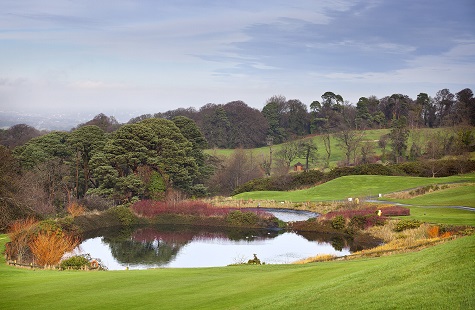
The man made lakes at Bray Golf Club are used as a drainage catchment and the water used to irrigate the course. Photo Alan Mahon
When you drive into the club your first impressions are of a tough hilly course that will test even the most agile of golfers. Despite the course being situated on the slopes of a hill, it has been designed in such a way that very little ‘climbing’ is required by the golfer. The fairways are flat and the course winds its way cleverly around the hills that you would forget you were on such an elavated site. It is the views you encounter during your round of golf that let you know you are among hills and mountains.
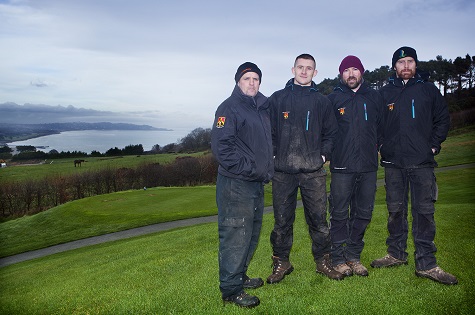
The greenkeeping staff from left: John Bishop, Eddie Treacy, Paul Clancy and Dave Nolan. Missing from photo are Stuart Loughman and Tobye Hillier. Photo Alan Mahon
The views are so diverse. On the front nine you see the Dublin and Sugar Loaf mountains. On the the back nine there is Killiney Bay and the town of Bray to behold, as well as the rock outcrops that form Bray Head, a popular recreational spot for hill walkers. Well known Olympic and professional boxer, Katie Taylor is often seen running across Bray Head as part of her training routine.
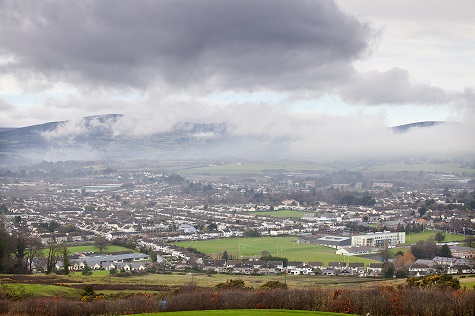
The course enjoys wonderful views, including part of Bray. Photo Alan Mahon
History
Bray Golf Club is one of the oldest clubs in the country. It was formed in 1897 as a nine-hole course. The choice of location was on land at Ravenswell, which was very close to Bray train station. This was a defining factor in choosing the site as, back in those days, the train was the main means of transport. Having a railway line running past the course also had its drawbacks. Apart from the noise of the steam engines, engine drivers were known to give a shrill blast of the whistle while golfers would be concentrating on making an important putt on some of the nearby greens.
John Bishop is the course superintendent at Bray Golf Club and has been working with the club for over 30 years. He fondly remembers working on the old nine-hole course at Ravenswell. “I lived beside the club and worked behind the bar as a lounge boy and then as a part time barman. I was offered summer work by Michael Walby, the club professional, who looked after the course with his son David. When I finished school I was offered a full time position and that’s when my love for Bray Golf Club started.”
The big move
The club remained at Ravenswell for 106 years before moving to its present location in 2003.
Bray Golf Club was one of the first clubs to benefit from the building boom that occured in Ireland between 2000 and 2008. In 2001, a developer approached the club and made them an offer that was too good to refuse. They were offered 176 acres of land on the outskirts of Bray, towards Greystones. The developer, with his carrot offer, also said that he would pay for the design and construction of the new course, build a new clubhouse and maintenance facility, equip the course with new machinery and, if that wasn’t enough, lodge a sum of money into the club’s bank account. What a dilemma the club faced! They ran with the offer and so the developer employed Declan Brannigan and former Ryder Cup golfer, Des Smyth to design the challenging layout. The greens were built to USGA specifications and sown with Penn A4 creeping bent grass.
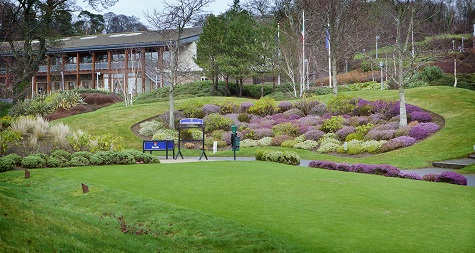
The 1st tee with beautiful heather planting. Photo Alan Mahon
The move from the old course to the new course was seamless. The last round of golf was played at Ravenswell on a Friday in June 2003 and the following day the first round was played on the new course.
During construction, John was busy commuting between the two courses. Maintaining the old course and checking on progress on the new course was difficult and challenging but it was also rewarding.
It was a major transformation for John and his staff moving from a nine-hole to an eighteen-hole course, with different soil and terrain to deal with, but they embraced the challenge. The underlying soil is relatively shallow, only 3 -4 inches in places. Shale lies not too far beneath so there is good drainage. To be cautious, a drainage system was installed during construction. Despite modern technologies that are available nowadays, local knowledge should never be sniffed at.
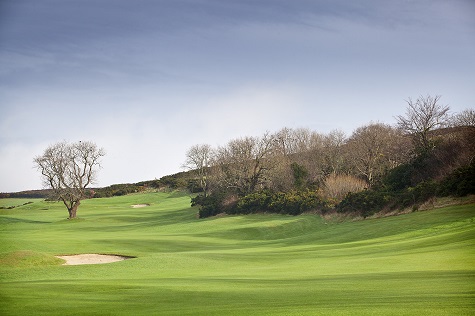
The 6th hole. Photo Alan Mahon
“I got friendly with one of the old estate workers during construction”, recalls John. “His name was Tommy Jenkinson and he lived in a cottage on the estate. He knew every nook and cranny and told me about old clay pipe drains that were installed decades previously that were still working. We tapped into these pipes and to this day our drainage system works very well”.
As we all know, golf clubs around Ireland suffered badly in the financial crash of 2008. Despite the good fortunes of the club, over the intervening years the greenstaff has gone from twelve to six. The staff that have remained have been extremely loyal to John and the club. To put things into perspective, three golf clubs within ten miles of the club have closed since 2008 - Glen of the Downs Golf Club, Kilcoole Golf Club and, only last year, Charlesland Golf Club. Some members of Charlesland Golf Club joined Bray Golf Club.
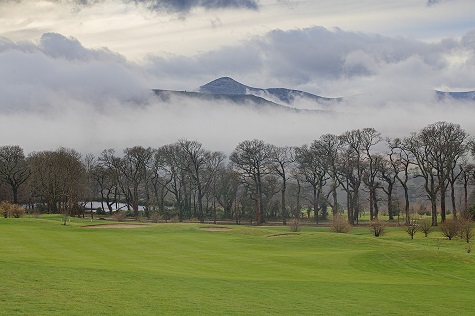
A view of the 12th fairway with the Sugar Loaf mountain surrounded by low cloud. Photo Alan Mahon
Maintenance
John and his staff maintain the course to the highest of standards. During December/January John cores, scarifies and sands the greens. He hires a GKB scarifier and sand filler. This machine has 4mm thick scarifying blades which go down to 15 -20mm into the rootzone, removing as much as 10% of thatch. He uses a specially prepared sand mix called ‘Profile’, which contains a porous ceramic substance mixed in with the sand. The sand is loaded into the sandfiller that is attached to the scarifying machine, which then fills the gaps. Getting the greens aerated so early in the year means that John does not have to do the usual spring and autumn coring and sanding, an operation that tends to frustrate golfers and club committees.
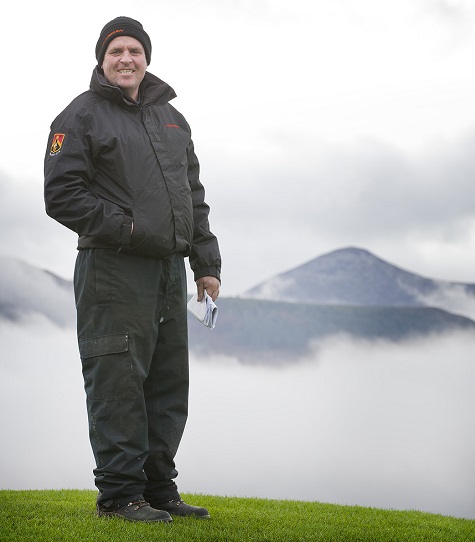
On top of the world. Course superintendent John Bishop. Photo Alan Mahon
Greens are pencil tined every month and given a light topdressing every two weeks during the growing season. Though the original greens were sown with Penn A4 creeping bent grass, annual meadow grass has since moved in. John, however, overseeds with Crystal Blue creeping bent grass, which is a new cultivar that has a high resistance to disease. John believes that overseeding is very important, especially when it comes to disease prevention. “With more and more fungicides being withdrawn from the market I feel it is important to select grass cultivars that have more didease resistance”, says John.
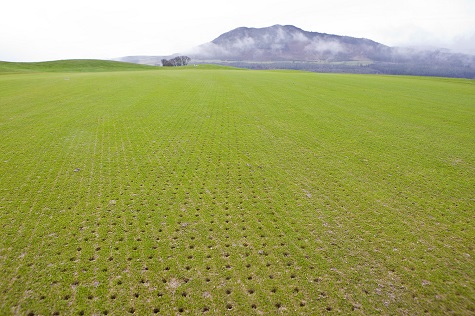
One of the greens after being cored. Photo Alan Mahon
It is in conjunction with the coring during December/January when John applies a granular feed on the greens. This usually consists of an organic 6:5:10 fertiliser. During the growing season a liquid feed and growth regulator is applied to the greens every 2-3 weeks. When autumn approaches this will change to a 6:5:18 feed or a 20:20:30 turf hardener every 3-4 weeks.
Because of the shallow soil, carrying out verti-draining on the fairways was difficult. The tines would often encounter rock. With that in mind John has replaced verti-draining with a Shockwave machine which is a more efficient way of relieving compaction.
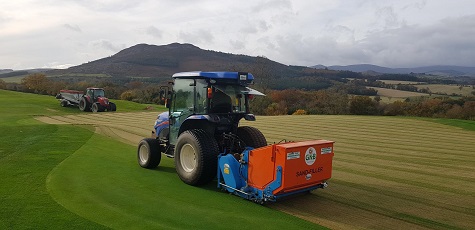
Deep scarification and sand filling in one pass. Photo John Bishop
There are 64 bunkers on the course and 3 man made lakes, which serve as catchment areas for the elaborate drainage system on the course. The biggest lake holds 13 million litres of water, so it will take a very severe drought for them to run dry. The water from the lakes is used for irrigation, which supports sprinklers on the fairways, tees and greens.
Within the 176-acre site there are some micro climate areas such as the 12th green. This is in a sheltered area of the course, surrounded by trees and can be prone to frost pockets when the rest of the course would be free of frost. The 13th tee was similar to the 12th green, where it was sheltered by a canopy of laurels. Four years ago it was decided to remove the laurels to get more air circulation around the tee box. The laurel branches were shredded and spread on the ground where they grew. The mature oak trees that were growing among the laurels have now become a feature of the hole where they look so elegant.
During the summer of 2016 it was the fairway sprinklers on the 11th hole that came to John’s rescue. A huge gorse fire broke out on Bray head, which spread right down to the edge of the course where the 11th hole is situated. Deer and other wild animals ran onto the course to seek refuge from the flames. John noticed that the grass on the fairway started to get warm. When he touched it, it felt hot and he was worried that, if left untreated, the grass would die. He decided to turn on the fairway sprinkler heads to try and cool down the grass. His plan seemed to have worked. No one knows how the fire started but, with so much wild gorse growing around Bray Head, the threat of more fires breaking out is always there.
Sustainability
John and his staff have introduced wild flower areas in the non-playing parts of the course and plan to introduce more wild flowers. It is a pleasant way to encourage wildlife onto the course, particularly pollinating insects. Last summer John installed a bee hive to encourage more pollinators into the wild flower areas.
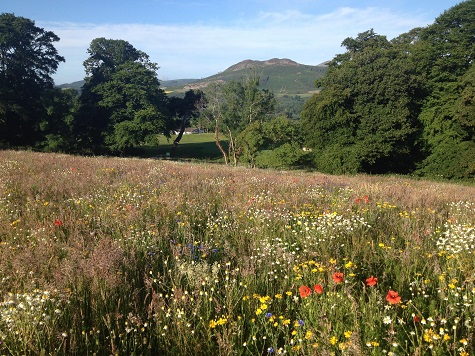
Wildflowers growing in an out of play area of the course. Photo John Bishop
In December 2020, as part of Bray Tree Week, 250 native trees were planted throughout the course. These trees contained a mix of oak, birch, mountain ash and alder. “I want to create as many wildlife corridors around the course that encourages wildlife”, says John.
Walking around the course one would think that it was around for over one hundred years, such is how mature it looks. Yet, it has only been there for 18 years. Having mature trees such as oak and scotts pine on site before the course was developed helps. However, with the hard work that is put into maintaining the course, blending the old with the new is a credit to John and his staff for making Bray Golf Club what it is today.

An aerial view of the course. Photo John Bishop